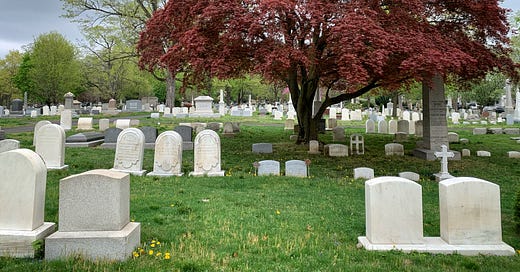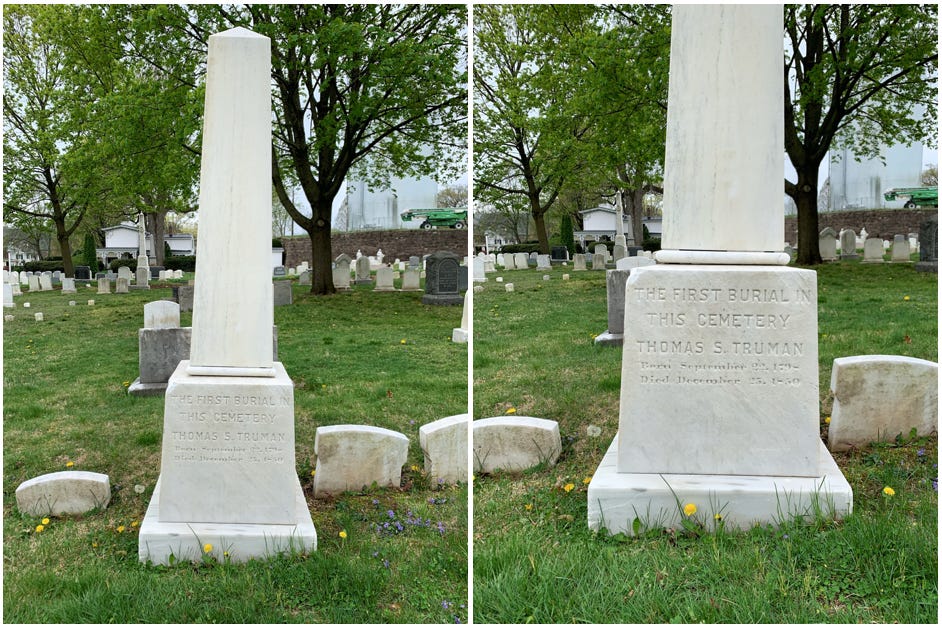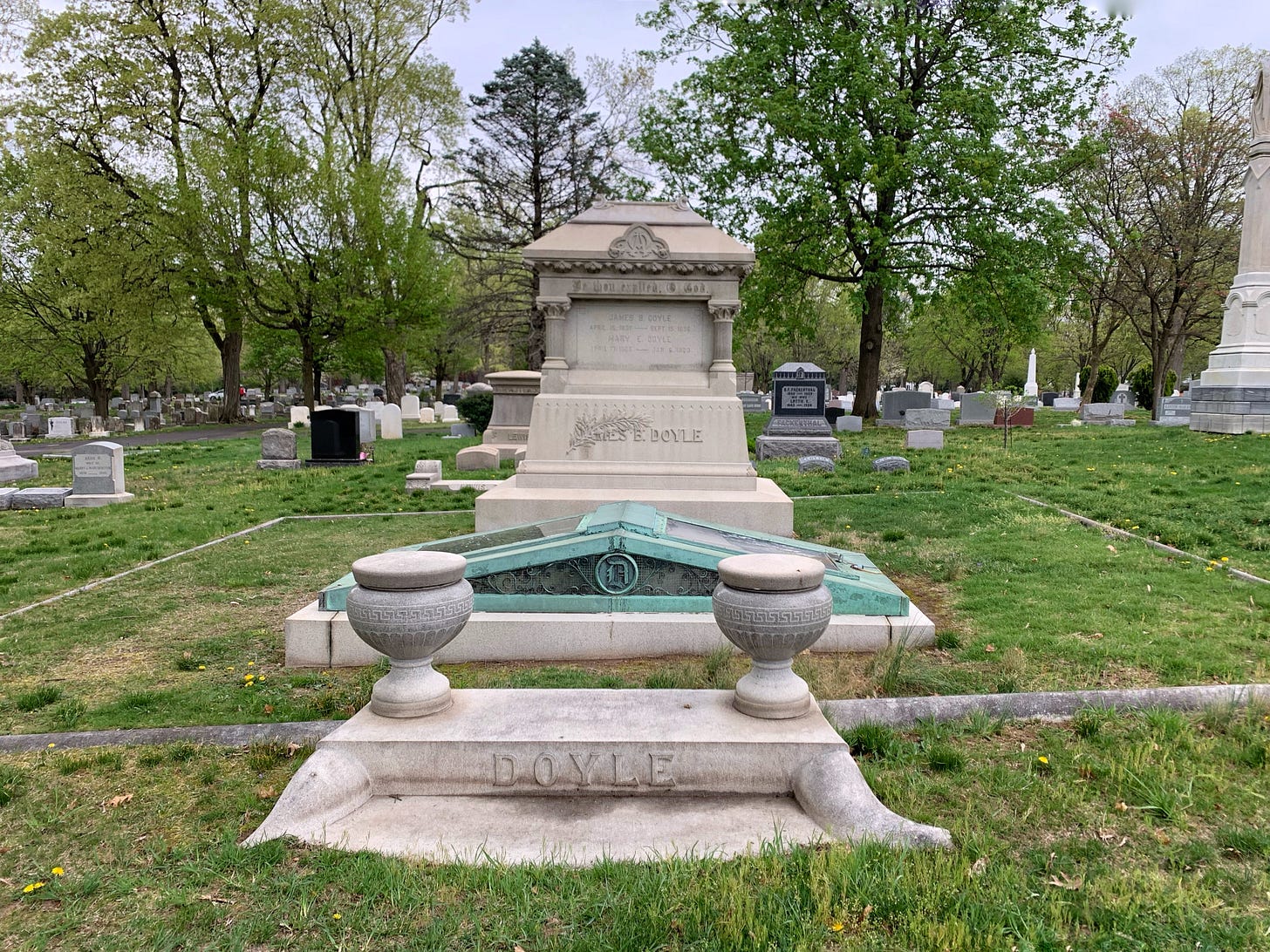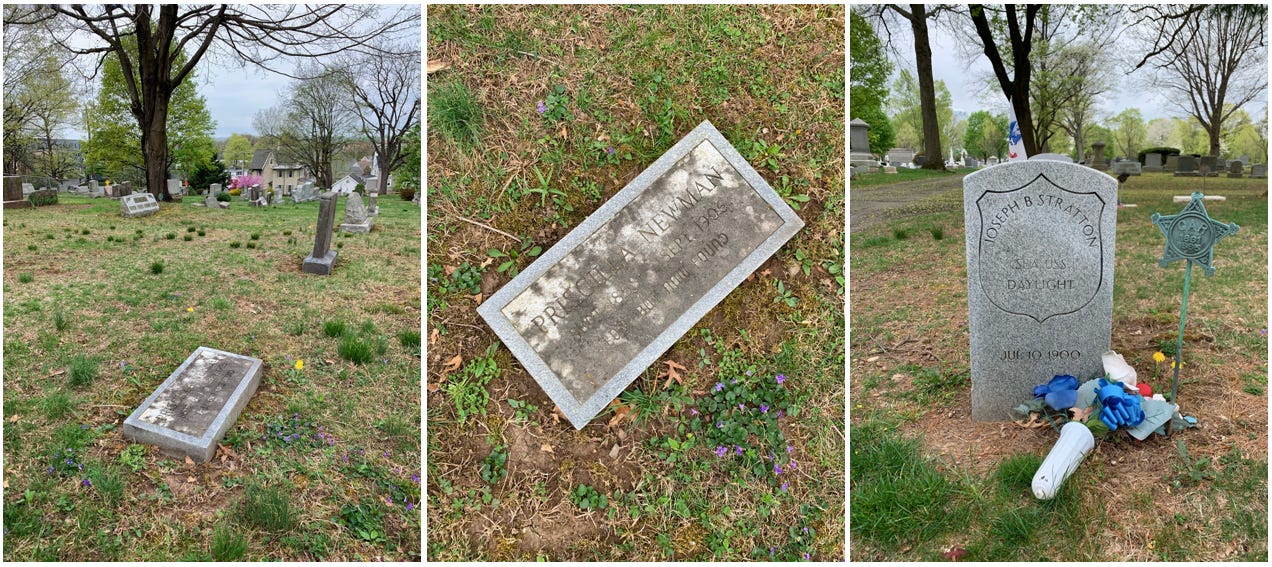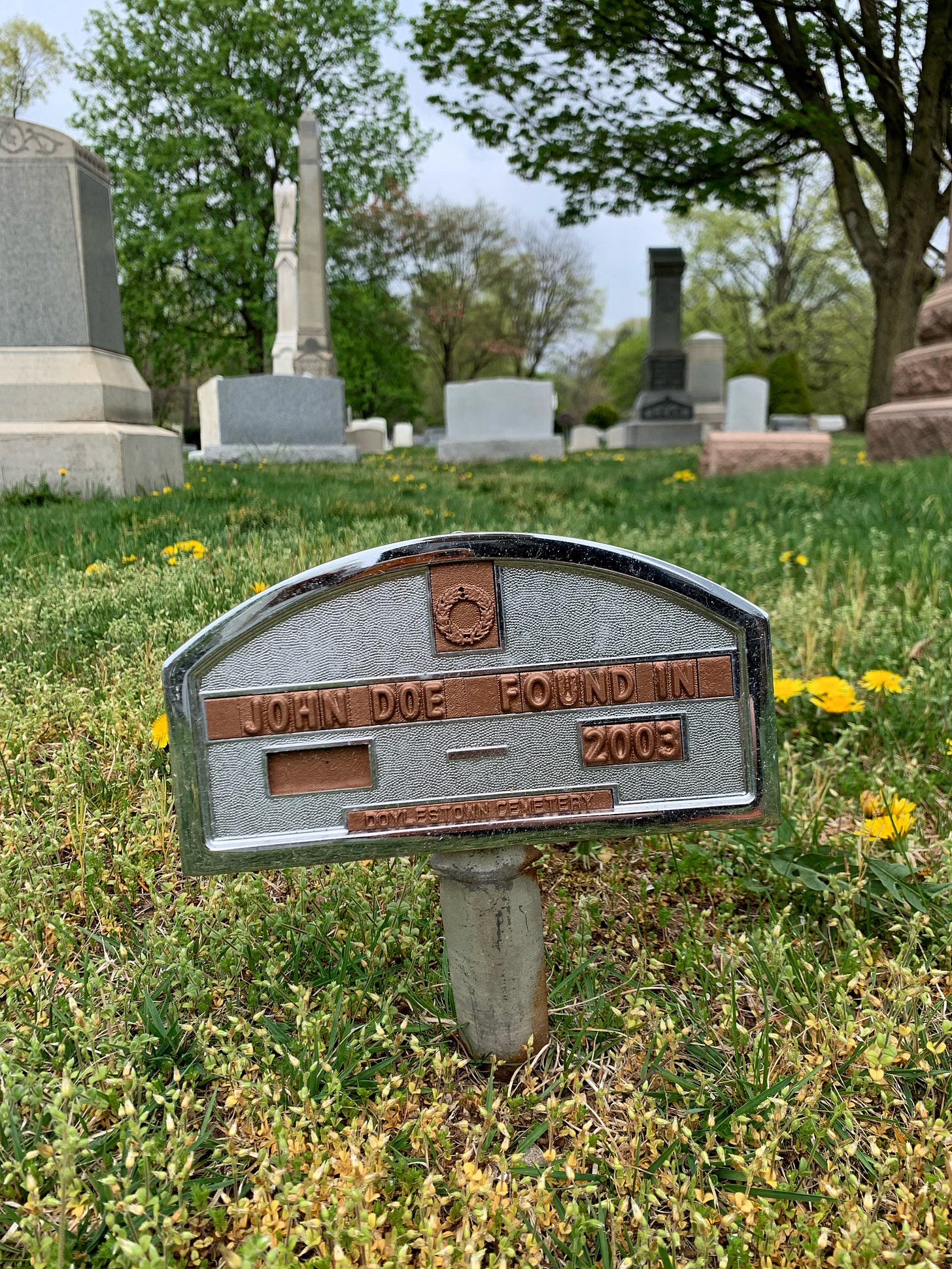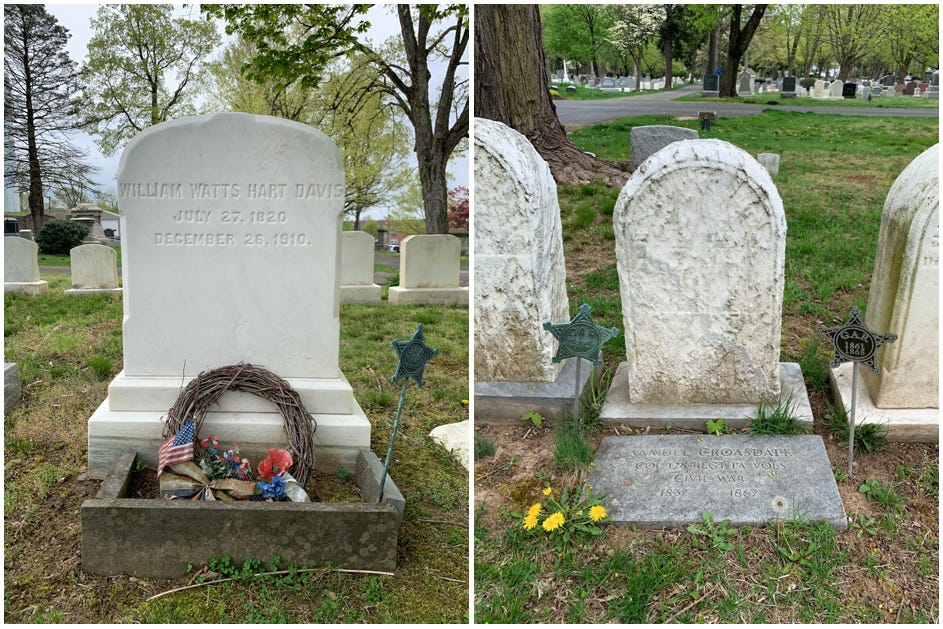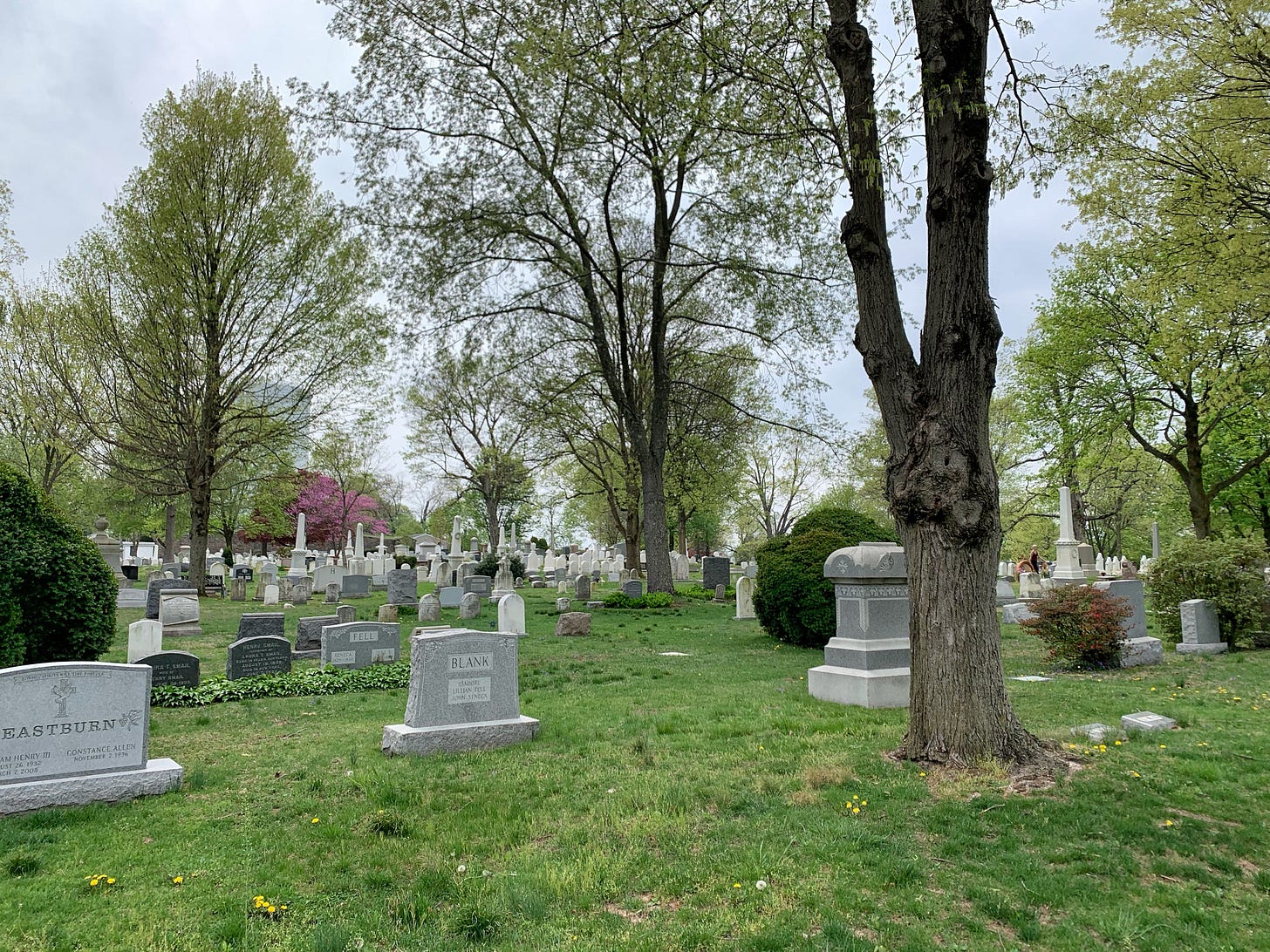Sunday Pastries With the Dead 23
Exploration part 2 of circa-1849 Doylestown Cemetery in Doylestown, PA.
As a continuation of last week’s cemetery visit, I’m detailing the notable people interred among the 12,500 graves at a gorgeous 33-acre 1849-era Pennsylvania burial ground (spoiler alert: I saved the best/weirdest/most macabre for last).
Before you read on, if you’d like to catch up on the atmosphere and lovely headstone symbols here, check out part one.
Fittingly, we begin with the first person buried at the cemetery in 1850, just one year after it was established. It’s very rare that a graveyard will signify its first burial on a headstone, so Thomas S. Truman’s marker is a real treat. His cause of death at age 52 is listed as “spinal.” Hmm.
Next, nestled within a stunning vine-covered stone wall, are the founder and heirs of a seed empire. You’ve definitely heard of these folks—their company, Burpee Seeds and Plants, is still going strong 147 years after its inception. Washington Atlee Burpee started the farm and plant facility in 1876 right here in the PA town where he’s buried, and it grew into the largest vegetable and flower seed company in the world. His son David, buried beside him here, took over after his death. Among their many achievements, the Burpees introduced iceberg lettuce in 1894, white marigold in 1976, and the biggest beefsteak tomato on record in 2014.
While we’re on the subject of prominent families, the relatives of the man after whom this PA town is named—William Doyle—are buried here. Their marker is footed by a gorgeous oxidized iron and glass entrance to a below-ground crypt. I peered in and was only able to glimpse a staircase and an arched entryway to what I’ll assume is a subterranean room beneath the large main headstone.
Ironically, just across from the plots of those “haves” is what used to be a spot for the “have-nots”—originally known as the Pauper Section for those of meager means who couldn’t afford grand headstones (or any markers at all). Among them is the grave of Priscilla Newman, the descendant of a free black man born in Philadelphia. Her father, Joseph B. Stratton, is buried on the other side of the cemetery, in a section largely devoted to veterans (JB served a year in the Union Navy during the Civil War). Priscilla was a twice-widowed mother of nine who moved to the town from Philadelphia in 1896; she died in 1906 and was buried without a headstone. This is an incredibly moving and spooky story about how Priscilla’s niece Doreen just happened to rent the nearby home Priscilla had lived in without realizing it (and how Priscilla haunted Doreen’s daughter). Once Doreen found out, she commissioned this headstone for her aunt, which reads Lost But Now Found.
Another haunting plot isn’t far from Priscilla’s—that of an as-yet-unidentified John Doe found washed up alongside the Delaware River in 2003.
In another walled-off family plot rests Juliana Rieser Force, the first director of the Whitney Museum of Art.
William Edgar Geil was a prominent photographer, author, and adventurer who specialized in documenting the Great Wall of China—his notes were even referred to for accuracy during the Wall’s restoration. Reverend Donald Grey Barnhouse was a prominent Presbyterian pastor and worship pioneer, author, and founder of Eternity magazine.
William Watts Hart Davis was a highly decorated Civil War general (the fingers on his right hand were blown off by shrapnel during a battle in South Carolina!) and later went on to found the Bucks County Pennsylvania Historical Society. Colonel Samuel Croasdale died at age 25 at Antietam, the bloodiest Civil War battle.
And now, for the promised pièce de résistance finisher. Within view from a far corner of the cemetery is an unassuming little yellow house that’s far more than meets the eye. During the first half of the 1800s, the plot upon which it’s built was the county’s potter’s field where prisoners, abandoned hospital patients, and unclaimed bodies were buried (oh, do I bet those walls talk and talk!) In 1855, the county ordered the dead to be exhumed and moved across the street to the new cemetery so they could sell the land. They were placed in what was then the back row (now in the center of the cemetery), called Strangers Row.
But, because the graves in the potter’s field and the early graves in Strangers Row were unmarked and their locations were rarely recorded, many believe at least some of the bodies were never actually disinterred and moved. Among them was a particularly notable person: “twice-buried” murderer Joseph Blundin.
Blundin was a farmhand who killed his coworker Aaron Cuttlehow while they were harvesting oats with several others on Sunday, July 27, 1834. According to witnesses, the two had engaged in an ongoing fight throughout the day, intermittently exchanging blows with fists and rocks. By the evening, Blundin finally lost it completely and stabbed Cuttlehow in the neck with his scythe. A jury convicted Blundin of murder, but there was a large public outcry because many believed he was driven to insanity by the victim’s beatings. There were appeals to have Blundin’s sentence commuted to life in prison, but ultimately he was sentenced to die by hanging on Friday, August 14, 1835. He escaped the jail the Sunday prior to his scheduled execution but was injured in the attempt—ultimately he was hanged and buried in the aforementioned potter’s field.
Was Blundin dug up and moved to the cemetery’s Strangers Row, where he now resides in an unmarked plot? Or does his body remain in the ground beneath the cheerful yellow house’s floorboards? We may never know…
Until next Sunday, fellow taphophiles!

